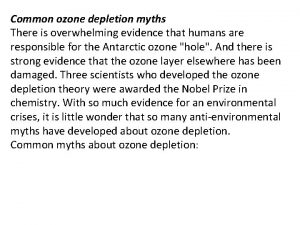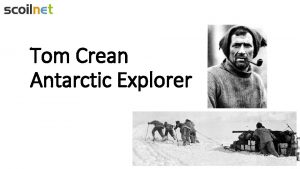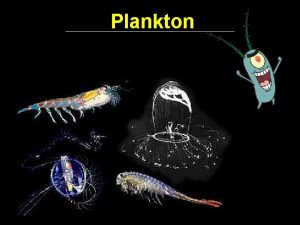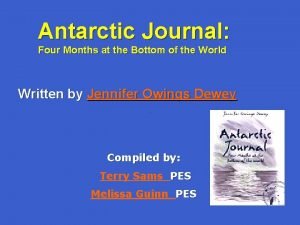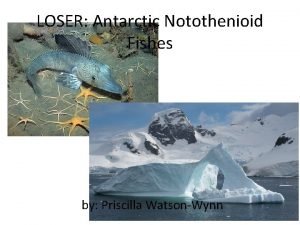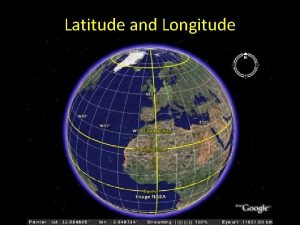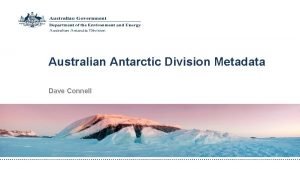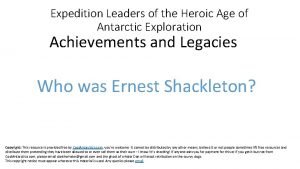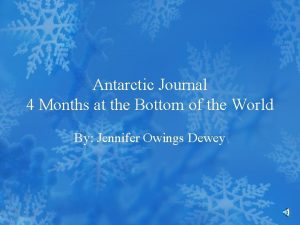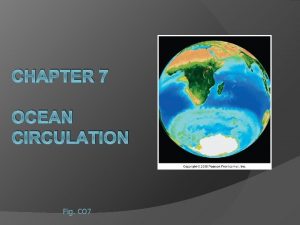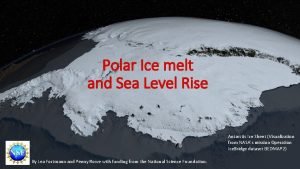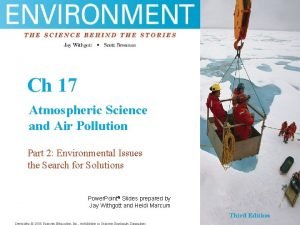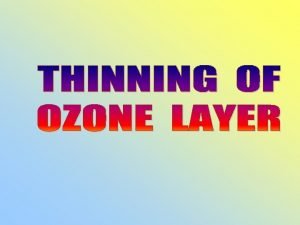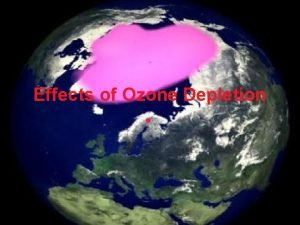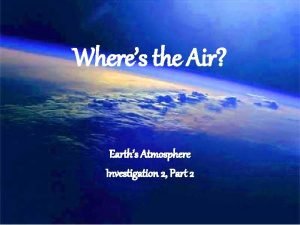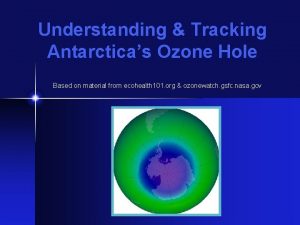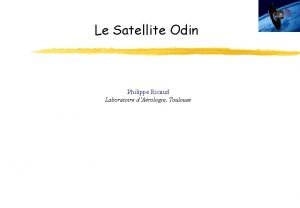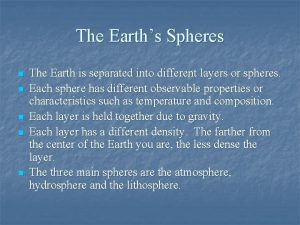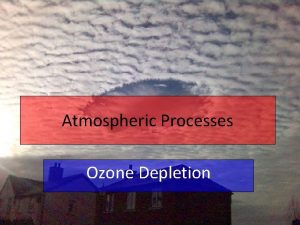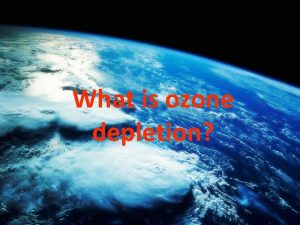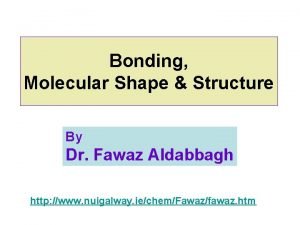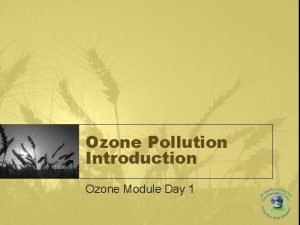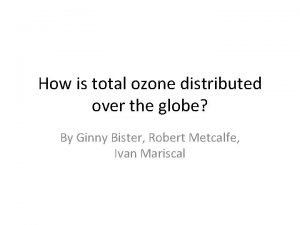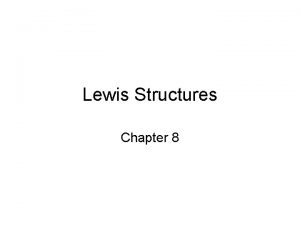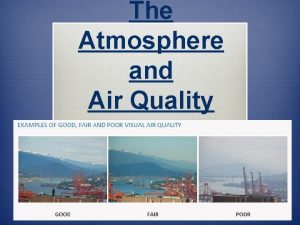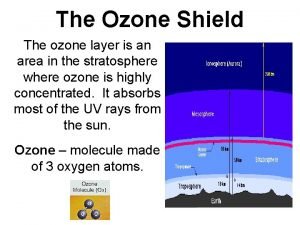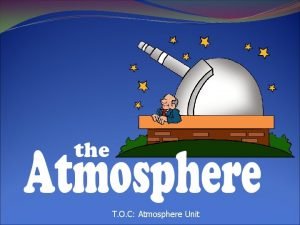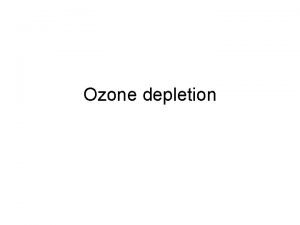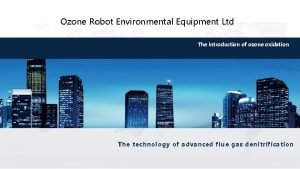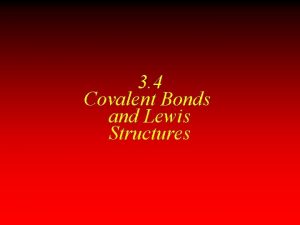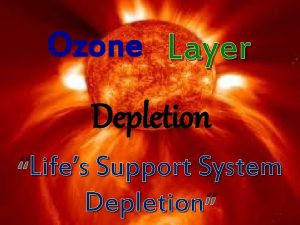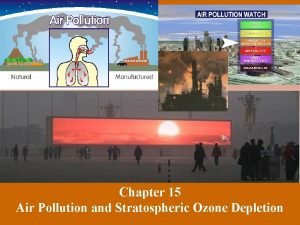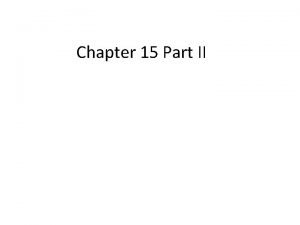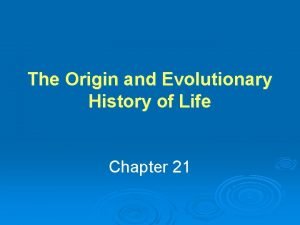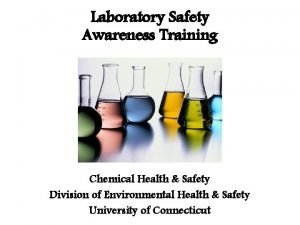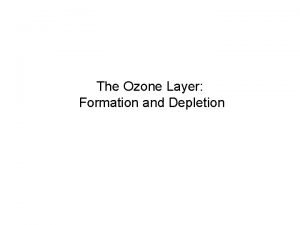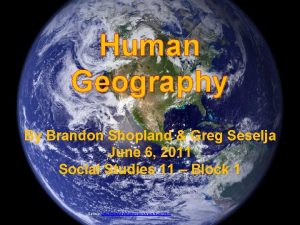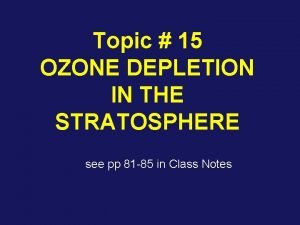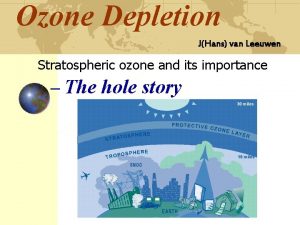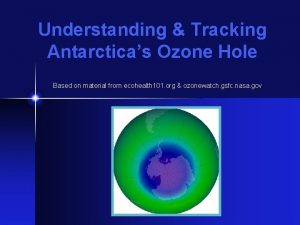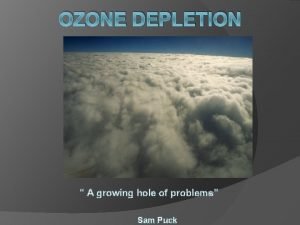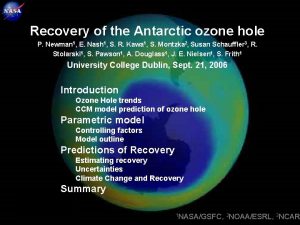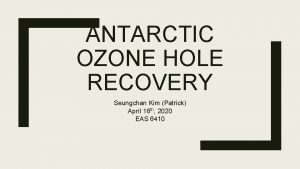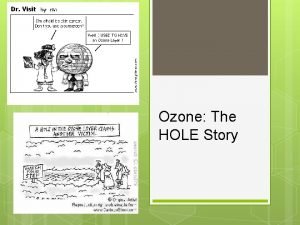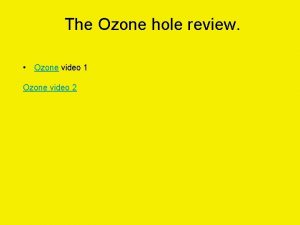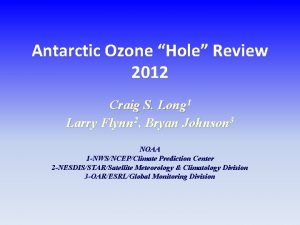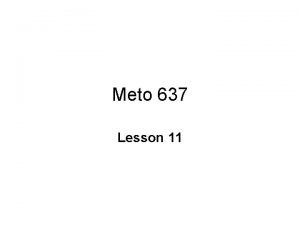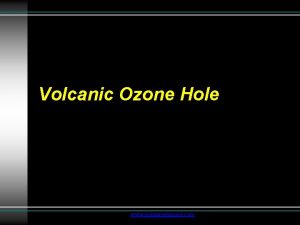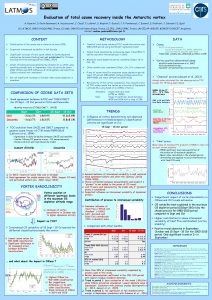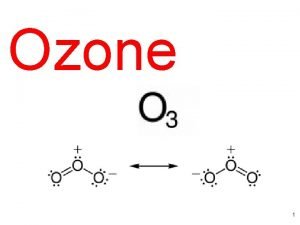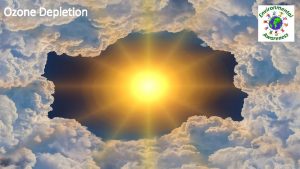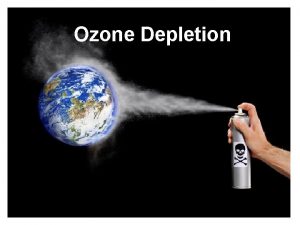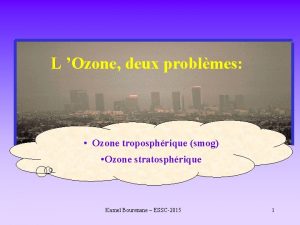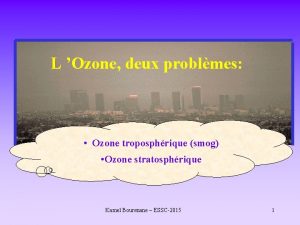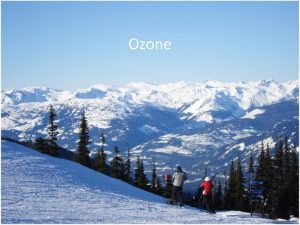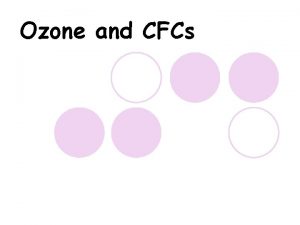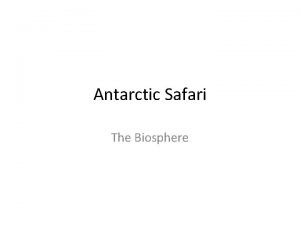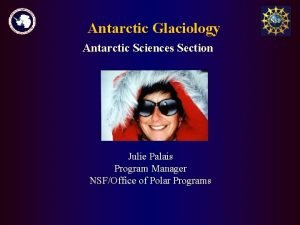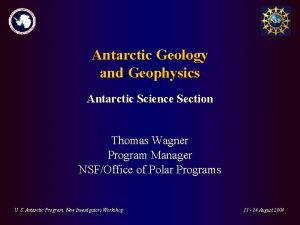1 Recovery of the Antarctic ozone hole P



























































- Slides: 59

1 Recovery of the Antarctic ozone hole P. Newman 1, E. Nash 1, S. R. Kawa 1, S. Montzka 2, Susan Schauffler 3, R. Stolarski 1, S. Pawson 1, A. Douglass 1, J. E. Nielsen 1, S. Frith 1 University College Dublin, Sept. 21, 2006 Introduction Ozone Hole trends CCM model prediction of ozone hole Parametric model Controlling factors Model outline Predictions of Recovery Estimating recovery Uncertainties Climate Change and Recovery Summary 1 NASA/GSFC, 2 NOAA/ESRL, 3 NCAR

2 Introduction

3 Why is understanding ozone hole recovery important? • The ozone hole is the poster child of atmospheric ozone depletion • Scientists staked their reputations on ozone depletion - international regulations were implemented. We need to carry our predictions through. • Severe ozone holes lead to acute UV events in mid-latitudes • Possible regulation changes could accelerate the phase out of ozone depleting chemicals. • The ozone hole is a fundamental example of mankind’s ability to alter our atmosphere and climate - forming a useful example on climate change policy

4 Ozone Hole Trends

5 TOMS 1984 Extremely cold temperatures are found in the lower stratosphere in spring and fall South America Extremely low values Green-blue indicates low ozone values, while orange-red indicated high values Antarctica Strong jet stream (the polar vortex) acts to confine ozone losses over Antarctica High values are normally found in the mid-latitudes October 1984 TOMS total ozone

October Average Ozone Hole Halley Bay Station Low Ozone High Ozone 6

7 October Antarctic Ozone

ozonewatch. gsfc. nasa. gov 8

9 Defining the Hole • Ozone hole area is defined by the area coverage of ozone values less than 220 DU = 24. 7 M km 2 • 220 DU located near strong gradient • 220 DU is lower than values observed prior to 1979 • Values of 220 tend to appear in early September. TOMS doesn’t make measurements in polar night! • Values of 220 tend to disappear in late November • Ozone hole minimum is 94 DU Antarctic Ozone Hole on Oct. 4, 1998

Daily Ozone Hole Area 24. 7 M km 2 on Oct. 4, 1998 Derive average size from an average of daily values: Sep. 7 -Oct. 13 10

11 Seasonal Ozone Hole Area

12 Current Conditions

13 Sept. 17, 2006 Ozone < 220 DU Aura OMI

15 Assessment of the ozone hole’s recovery (WMO, 2003) Chapter 3 - Polar Ozone

16 Model area estimates WMO Fig. 3 -47

17 Model area estimates WMO Fig. 3 -47

18 Model area estimates WMO Fig. 3 -47

19 Minimum Ozone WMO Fig. 3 -47

20 Model Predictions Summary • WMO assessment (2004): “These models suggest that the minimum column ozone may have already occurred or should occur within the next decade, and that recovery to 1980 levels may be expected in the 2045 to 2055 period. ” • CCM losses tend to be too small • All of the CCMs underestimate the ozone hole area. • In general, the CCMs overestimate the depth of the ozone hole.

21 What controls Antarctic ozone losses?

22 PSCs 1. 2. PSC composition & phase are key to heterogeneous reaction rates • II - Crystaline water Ice ~ 188 K • Ia - Crystaline particles above frost point ~ 195 K • Ib - liquid particles above the frost point ~ 192 K PSCs control de-nitrification and de-hydration, which influences ozone loss Photo: Paul A. Newman - Jan. 14, 2003 - Southern Scandanavia

23 Antarctic ozone hole theory Solomon et al. (1986), Wofsy and Mc. Elroy (1986), and Crutzen and Arnold (1986) suggest reactions on cloud particle surfaces as mechanism for activating Chlorine HCl Cl. ONO 2 Cl 2 HNO 3 Cl 2 is easily photolyzed by UV & blue/green light HNO 3 is sequestered on PSC

24 Polar Ozone Destruction 1. O 3 + Cl Cl. O + O 2 3. Cl. OOCl+h 2 Cl+O 2 2 O 3 3 O 2 2. 2 Cl. O + M Cl. OOCl + M Only visible light (blue/green) needed for photolyzing Cl. OOCl No oxygen atoms required Net: 2 O 3 + h 3 O 2

25 Chlorine and Bromine Ozone (ppmv) NOZE 1 & 2 missions in 1986: Highconcentrations of chlorine monoxide at low altitudes in the Antarctic spring stratosphere - diurnal-variations, R. Dezafra, M. Jaramillo, A. Parrish, P. Solomon, B. Connor, J. Barrett, Nature, 1987 AAOE mission in August-September 1987: observations inside the polar vortex show high Cl. O is related to a strong decrease of ozone over the course of the Antarctic spring: J. Anderson et al. , JGR, 1989 Latitude (˚S)

26 Ozone Hole Area Versus Year Polar vortex ≈ 33 Million km 2

27 Ozone Hole Residual Area Vs. T If the temperature is 1 K below normal, then ozone hole’s area will be 1. 1 Million km 2 larger than normal. See Newman and Nash, GRL, 2004 O residual area: 9/21 -9/30 3 T: 9/11 - 9/20, 50 h. Pa, 55 -75ºS

28 Problem • We have reasonably good estimates of temperatures over Antarctica from radiosondes and satellite temperature retrievals • We only have snapshots of Cl and Br over Antarctica • How can we estimate Cl and Br over Antarctica for all of our observed ozone holes?

29 Chlorine over Antarctica

30 Ozone Loss Source Chemicals • Surface concentrations ~ 1998 • Cl is much more abundant than Br • Br is about 50 times more effective at O 3 destruction From Ozone FAQ - see http: //www. unep. org/ozone/faq. shtml

Atmospheric Chlorine Trends from NOAA/ERL - Climate Monitoring Division 31 102 years CFC-12 992 FCs d Stea f. C th o o 1 up t CFC-11 ow y gr CH 3 CCl 3 CFC-113 50 years Production fully banned in US by Pres. Bush CCl 4 42 years 85 years Updated Figure made by Dr. James Elkins from Trends of the Commonly Used Halons Below Published by Butler et al. [1998], All CFC-113 from Steve Montzka (flasks by GC/MS), and recent updates of all other gases from Geoff Dutton (in situ GC).

32 CFC-12 (CCl 2 F 2) pathway to Antarctica 0. 01 80 48 2 Carried into stratosphere HCl and Cl. ONO 2 in the tropics by slow rising circulation react on the surfaces of PSCs 16 0. 1 1 10 32 Pressure (h. Pa) Altitude (km) 64 Cl catalytically destroys O 3 photolyzed in Cl reacts with CH 4 CFC-12 or by solar UV, NO 2 to form HClstratosphere or releasing Cl Cl. ONO 100 CFC-12 released in troposphere 0 -90 -60 -30 0 Latitude 30 60 1000 90

33 Mean Age-of-air

CCM mean age-of-air (Sept. ) GSFC GEOS-4 mean age-of-air derived from advected age tracer. Magenta line is the tropopause, white lines are zonal mean zonal wind Grey lines schematically show mean flow. 34

CCM mean age-of-air (Sept. ) 35 Air at a particular point in the stratosphere is a mixture of air parcels that have come together from a multitude of pathways with different times of transit. This “spectrum” of transit time forms an “age-spectrum” that has a mean value and a spectrum “width”

36 Age Spectra The spectrum is convolved with the surface observation time series to yield the stratospheric time series.

37 Fractional Release

38 CCM mean age-of-air (Sept. ) 4 -year 3 -year CFC-11 Inorganic 2 -year CFC-11 Inorganic 0 -year CFC-11 1 -year CFC-11 5 -year

CCM mean age-of-air (Sept. ) If we know the mean age of air ( ), and we know the fractional release rate as a function of , then we can estimate the chlorine available from CFC-11 for ozone loss Inorganic 0 -year Inorganic CFC-11 5 -year 39

40 CFC-11 break down Schauffler et al. (2003)

41 Estimating chlorine over Antarctica

42 Estimating halogen (Cl & Br) levels over Antarctica • Observations show that it takes about 5. 5 years for air to get to the Antarctic stratosphere - tropospheric CFCs in January 2000 yield Antarctic stratospheric Cl in July 2005! • We use observed CFCs & mean age-of-air estimates to calculate fractional release rates as a fcn. of age • EESC = equivalent effective stratospheric chlorine n = # Cl or Br atoms, f = release rate, = chemical mixing ratio, = scaling factor to account for Br efficiency for ozone loss

EESC Observed total chlorine* (surface) Estimated stratospheric chlorine 43

44 Parametric model of the ozone hole Method fit ozone hole size to quadratic functions of EESC and temperature

45 Ozone Hole Parametric Model Area is a function of Effective Equivalent Stratospheric chlorine (EESC) and temperature EESC = 0. 8 G(CCly) + G(CBry) G = Age Spectrum (6 year mean age, 3 year width) CCly and CBry from WMO (2003) EESCmax = 3. 642 ppbv a 0 = -69. 5 million km 2 a 1 = 50. 9 million km 2/ppbv a 2 = -1. 08 million km 2/K A = 0 for EESC = 1. 817 ppbv = residual area r = 0. 971 (r 2=. 943)

46 Recovery Predictions

47 Ozone Hole Area vs. Year (1)

48 Ozone Hole Area vs. Year (2) Temperature effect is removed

49 Ozone Hole Area vs. Year (3) (92) Black line represents the fit of area to EESC Area residual = 1. 8 M km 2 Unexplained residual for 1992 ~ 3 m km 2

50 Ozone Hole Area vs. Year (4) Using WMO (2003) Cly and Bry projections, we use our fit to project the ozone hole area

51 Ozone Hole Area vs. Year (5)

52 Add uncertainty to fits • EESC: We assume mean age = 5. 5 years and the spectrum width = 2. 75 years = EESC 0 – Monte Carlo mean age ( = 0. 5 years) and width ( = 0. 5 years) to generate new EESC time series = EESC 1 – Add 80 pptv of “noise” to EESC 1 = EESC 2 • Area: Use original area fit (A 0) + added noise re-sampled from area residuals = A 1 • Refit new Area (A 1) as a function of EESC 2 • Project forward using EESC 1 for calculating new recovery dates

53 Ozone Hole Area vs. Year (6) • • • The ozone hole area peaked in 2001 from the area fit to EESC The ozone hole area will remain large (and relatively unchanged for 20 years (1997 -2017) Area will start decreasing in approximately 2017 • • • The area will have decreased 1 - by 2018 and 2 - by 2027 Based upon our boot-strap statistics, recovery will first be detected in 2024 The area will be zero in 2070

54 Uncertainties

55 Uncertainties • Are the chlorine and bromine levels over Antarctica well represented by using WMO (2003) and an age-spectrum for the 1979 -2004 period? • How good is WMO (2003)? New revisions (A 1) increased recovery to 2070 from 2068. • Is a 5. 5 year mean age and a 2. 75 width appropriate for the age spectrum? • How do we represent interannual variability in age, Cly and Bry estimates? • Will climate change impact H 2 O levels and the initial conditions for the ozone hole?

56 Full Recovery vs. mean age-of-air • The recovery dates are proportional to our estimate of the mean age-of-air inside the Antarctic vortex: Age sensitivity=9. 0 yr/yr • Critical to improve our understanding of age in the vortex and to understand age variation in future climate scenarios

57 Climate change effect on ozone hole recovery

58 How will climate change impact the ozone hole? -0. 25 K/decade cooling CMIP 2 data from IPCC (2001) No trend • • • Peak size 2011 (2004) Area will start decreasing in approximately 2018 (2017) The area will have decreased 1 - by 2025 (2024) and 2 - by 2031 (2029) Based upon our boot-strap statistics, recovery will first be detected in 2028 (2027) The area will be zero in 2079 (2075) magenta - no T-trend

59 Summary • • The area of the ozone hole is well represented by T and Cl and Br - We can use this to predict future size and minimum values of Antarctic ozone. Based upon our parametric model: • The ozone hole will remain large for a least another decade with no evidence of improvement • Actual decreases will begin in about 2017, but can not be detected until 2023 • The full recovery will not occur until 2070 • GHG change will have small impact on recovery • • Recovery is strongly dependent on age-of-air and future CFC scenarios Current coupled models are still inadequate for recovery predictions

60 END Jan. 10, 2003 - local noon, Kiruna, Sweden
 Ozone hole myth
Ozone hole myth Tom crean antarctic explorer
Tom crean antarctic explorer Plankton adalah
Plankton adalah Antarctic pearlwort
Antarctic pearlwort Antarctic journal four months at the bottom of the world
Antarctic journal four months at the bottom of the world Antarctic circumpolar current
Antarctic circumpolar current Antarctic circle
Antarctic circle Australian antarctic data centre
Australian antarctic data centre Cool antarctica.com
Cool antarctica.com Antarctic expedition
Antarctic expedition Journeys antarctic journal comprehension test
Journeys antarctic journal comprehension test Antarctic circumpolar current
Antarctic circumpolar current Antarctic toothfish price
Antarctic toothfish price Ground level ozone effects
Ground level ozone effects Ozone layer depletion
Ozone layer depletion Ozone layer made up of
Ozone layer made up of Ozone depletion effects on humans
Ozone depletion effects on humans Atmega44
Atmega44 Wheres the ozone layer
Wheres the ozone layer Cause of ozone depletion
Cause of ozone depletion Ozone layer depletion introduction
Ozone layer depletion introduction Philippe odin
Philippe odin Ozone blanket
Ozone blanket Protective ozone layer
Protective ozone layer Ozone nasa
Ozone nasa Ozone solid state
Ozone solid state Protection of ozone layer
Protection of ozone layer Nh4 + molecular geometry
Nh4 + molecular geometry Protective ozone layer
Protective ozone layer Ozone klavye
Ozone klavye Ozone without borders
Ozone without borders How is total ozone distributed over the globe
How is total ozone distributed over the globe Phosphate ion lewis structure
Phosphate ion lewis structure Sulphur oxide
Sulphur oxide Effect of ozone depletion on plants
Effect of ozone depletion on plants The ozone layer protects us from
The ozone layer protects us from Ozone layer
Ozone layer Size multiplier vray sun
Size multiplier vray sun Poisonous
Poisonous Ozone lewis structure
Ozone lewis structure Ozone layer depletion
Ozone layer depletion How is smog formed
How is smog formed Ozone layer levels
Ozone layer levels Jamoytius
Jamoytius Ozone hazard symbol
Ozone hazard symbol Sopmed training
Sopmed training How do cfcs destroy ozone
How do cfcs destroy ozone Herbicides definition ap human geography
Herbicides definition ap human geography Ozone depletion diagram
Ozone depletion diagram Stratospheric ozone depletion
Stratospheric ozone depletion Ozone layer
Ozone layer Ozone layer facts
Ozone layer facts Dot
Dot Nguyên nhân của sự mỏi cơ sinh 8
Nguyên nhân của sự mỏi cơ sinh 8 Vẽ hình chiếu đứng bằng cạnh của vật thể
Vẽ hình chiếu đứng bằng cạnh của vật thể Phản ứng thế ankan
Phản ứng thế ankan Gấu đi như thế nào
Gấu đi như thế nào Thiếu nhi thế giới liên hoan
Thiếu nhi thế giới liên hoan Khi nào hổ con có thể sống độc lập
Khi nào hổ con có thể sống độc lập điện thế nghỉ
điện thế nghỉ
